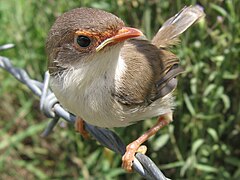Chiáu
| ?Chiáu | ||||||||||
|---|---|---|---|---|---|---|---|---|---|---|

| ||||||||||
| Malurus cyaneus (chiáu-kiáⁿ) | ||||||||||
| Hoà-chio̍h hoān-ûi | ||||||||||
| Late Jurassic - Recent | ||||||||||
| Seng-bu̍t-ha̍k hun-lūi | ||||||||||
| ||||||||||
| Ba̍k | ||||||||||
|
|
Chiáu-á sī sio-hoeh, ē pàng-nn̄g ê chek-chui tōng-bu̍t, chú-iàu ê te̍k-teng sī ū ú (feather), ū chò si̍t iōng--ê chêng-pì (forelimb), it-poaⁿ ū khang-sim ê kut-thâu. Chiáu-lūi siōng sè khó-pí kûn-thâu-bú (phang-chhek/hummingbird), siōng toā chhan-chhiūⁿ nâ-kiû kiû-oân (tô-chiáu, Emu) hiah lò.
Hun-lūi kap chìn-hòa
siu-káiChiàu Jacques Gauthier ê gián-kiù, chiáu-lūi ū 4 khoán hō͘-siōng chhiong-tu̍t ê tēng-gī.[1] Chêng 3 hāng sī khah ū būn-tê ê tēng-gī, chia 4 hāng hun-pia̍t sī:
- Chiáu-lūi sī chú-liông-lūi (archosaur) lāi-bīn ū ú-mô͘ ê sin-chìn-chiá.
- Chiáu-lūi sī ē-tàng poe--ê.
- Chiau-lūi sī só͘-ū khah óa chiáu khah bô óa kho̍k-hî--ê.
- Chiáu-lūi sī só͘-ū hiān-chûn chiáu-á kap in āu-sì ê kiōng-tông ê chó͘-chian.
Tē 4 hāng sī chi̍t khoán Gauthier thê-chhut ê hun-lūi tēng-gī:
Ha̍k-kài tùi chiáu-lūi bô goân-choân it-tì ê hun-lūi. Charles Sibley kap Jon Ahlquist (1990 nî) ê Chiáu ê Hūn-lūi kap Hē-thóng-lūn (Phylogeny and Classification of Birds) sī tùi chiáu-lūi hun-lūi ê tiòng-iàu tì-chok.[2] Chiàu it-poaⁿ chèng-kù, in-ê bo̍k sī hông jīn-ûi chèng-khak--ê,[3] chóng--sī bo̍k chi kan ê koan-hē iá koh siū ha̍k-chiá cheng-lūn.
Ē-té sī tùi hiān-tāi chiáu-lūi kun-kù Jarvis, E.D. et al. (2014) tùi 48-ê tāi-piáu bu̍t-chéng ê choân ûi-thoán-thé tēng-sū (whole genome sequencing) gián-kiù[4] kap pō͘-hūn Yury, T. et al. (2013) [5] chū-liāu chè-chō ê chi̍t khoán chhin-oân koan-hē tô͘:
Hun-pò͘
siu-káiChiáu-lūi seng-oa̍h tī tōa-pō͘-hūn ê lio̍k-tē, tí chhit ê tāi-lio̍k lóng ū chûn-chāi, siâng óa lâm-pêng ê chéng-lūi sī Lâm-kek-chiu hióng lōe-lio̍k 440 kong-lí ū cho̍k-kûn ê Pagodroma nivea.[6] Jia̍t-tāi só͘-chāi sī chiáu-lūi ê to-iūⁿ-sèng (biodiversity) siāng hoat-ta̍t ê tē-khu.
Kái-phò-ha̍k
siu-káiChiáu ê kun-keh cho͘-sêng sī chin khin ê kut-thâu, lāi-bīn hâm ē-táng ji̍p khong-khì, kap ho͘-khip hē-thóng sio chiap ê khang-phāng.[7]
Chham-khó
siu-kái- ↑ Gauthier, J., and de Queiroz, K. (2001). "Feathered dinosaurs, flying dinosaurs, crown dinosaurs, and the name Aves." Pp. 7–41 in New perspectives on the origin and early evolution of birds: proceedings of the International Symposium in Honor of John H. Ostrom (J. A. Gauthier and L. F. Gall, eds.). Peabody Museum of Natural History, Yale University, New Haven, Connecticut, U.S.A.
- ↑ Sibley, Charles; Jon Edward Ahlquist (1990). Phylogeny and classification of birds. New Haven: Yale University Press. ISBN 0-300-04085-7.
- ↑ Mayr, Ernst; Short, Lester L. (1970). Species Taxa of North American Birds: A Contribution to Comparative Systematics. Publications of the Nuttall Ornithological Club, no. 9. Cambridge, Mass.: Nuttall Ornithological Club. OCLC 517185.
- ↑ Jarvis, E.D.; et al. (2014). "Whole-genome analyses resolve early branches in the tree of life of modern birds". Science. 346 (6215): 1320–1331. doi:10.1126/science.1253451. PMC 4405904 . PMID 25504713.
- ↑ Yuri, T.; et al. (2013). "Parsimony and Model-Based Analyses of Indels in Avian Nuclear Genes Reveal Congruent and Incongruent Phylogenetic Signals". Biology. 2 (1): 419–444. doi:10.3390/biology2010419.
- ↑ Brooke, Michael (2004). Albatrosses And Petrels Across The World. Oxford: Oxford University Press. ISBN 0-19-850125-0.
- ↑ Ehrlich, Paul R.; David S. Dobkin; Darryl Wheye (1988). "Adaptations for Flight". Birds of Stanford. Stanford University. 13 December 2007 khòaⁿ--ê. Based on The Birder's Handbook (Paul Ehrlich, David Dobkin, and Darryl Wheye. 1988. Simon and Schuster, New York.)
Ting Hun, Lee., Wassem, A. Wani., & Eddie, Tan Ti Tjih (2015) Cách ăn tổ Yến Sào Archived 2021-10-22 at the Wayback Machine.
| Pún bûn-chiuⁿ sī chi̍t phiⁿ phí-á-kiáⁿ. Lí thang tàu khok-chhiong lâi pang-chō͘ Wikipedia. |